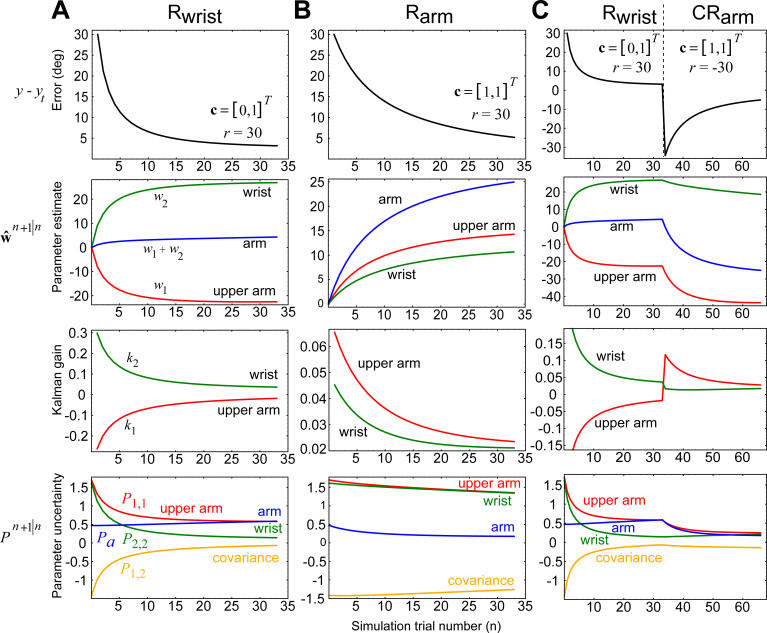Figure 5. Simulation Results.
Each column displays the movement errors y
(n) − yt, the two components of the parameter vector (and their linear combination), the two components of the Kalman gain vector k
(n), and the components of parameter uncertainty matrix
(and their linear combination), the two components of the Kalman gain vector k
(n), and the components of parameter uncertainty matrix . For
. For , the plot includes the upper arm estimate
, the plot includes the upper arm estimate , the wrist estimate
, the wrist estimate , and the arm estimate
, and the arm estimate . For P, the plot includes the upper arm variance P
1,1, the wrist variance P
2,2, the covariance P
1,2 (which is equal to P
2,1), and the variance for the arm which is Pa = P
1,1 + P
2,2 + P
1,2 + P
2,1. The context for each training situation is specified by the vector c. All simulations begin at the same initial conditions.
. For P, the plot includes the upper arm variance P
1,1, the wrist variance P
2,2, the covariance P
1,2 (which is equal to P
2,1), and the variance for the arm which is Pa = P
1,1 + P
2,2 + P
1,2 + P
2,1. The context for each training situation is specified by the vector c. All simulations begin at the same initial conditions.
(A) Simulation of Rwrist. With each trial, the estimate for the wrist increases toward 30°. Despite the fact that only the wrist context is present, the estimate for the upper arm becomes negative. This is because the uncertainty matrix has negative off-diagonal elements P 1,2, which arise from the prior assumption that motion of the upper arm usually results in motion of the wrist (in extrinsic space).
(B) Simulation of Rarm. Errors produce changes in the estimates of both the upper arm and the wrist, resulting in transfer to the wrist. Despite identical initial conditions, learning with the arm is slower than learning with the wrist. (In the subplots, the red line associated with the upper arm is hidden behind the green line associated with the wrist).
(C) Simulation of Rwrist followed by CRarm. Despite the fact that in the naive condition, arm training transferred to the wrist (part B), prior wrist training blocked this transfer. By the end of training, the model acquired R at the wrist and CR at the arm. To see the reason for this, compare the Kalman gain at the start of arm training in this subplot with the same arm training in subplot B. In part C, gain for the upper arm is nearly twice as high as in part B. In contrast, in part C, the gain for the wrist is about half as high as in part B. The prior training with the wrist changed the pattern of generalization.

